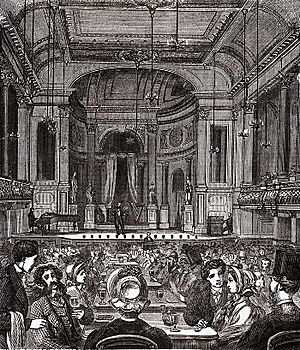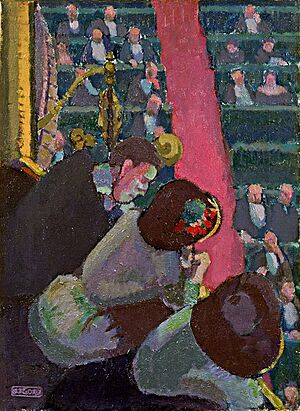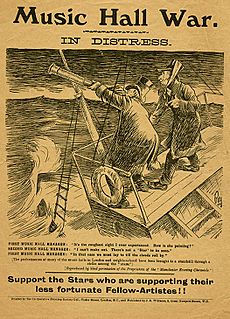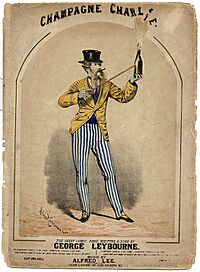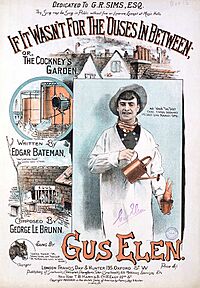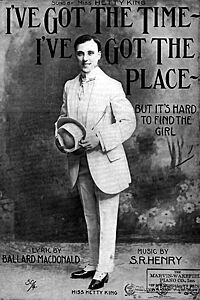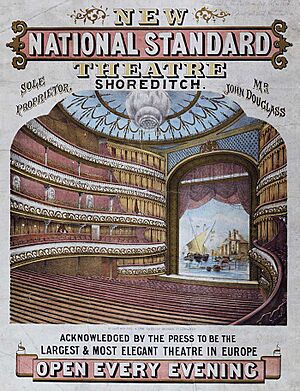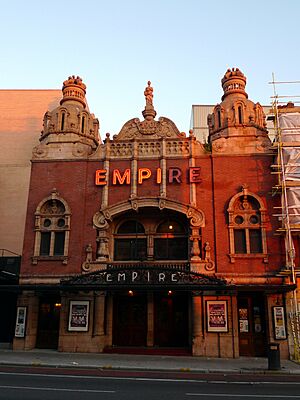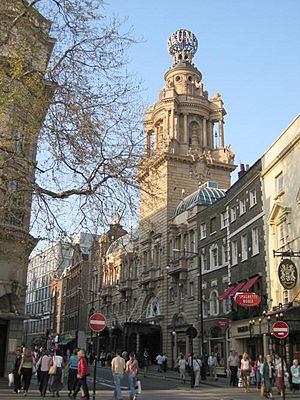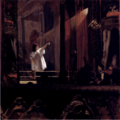Music hall facts for kids
Quick facts for kids Music hall |
|
|---|---|
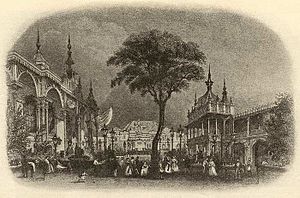
The Eagle Tavern in 1830
|
|
| Stylistic origins | Building:
|
| Cultural origins | 18th century, United Kingdom |
| Other topics | |
| Pantomime | |
Music hall was a popular type of live entertainment in Britain. It was most famous from the mid-1800s until after World War I. Music hall shows featured a mix of popular songs, funny acts, and special performances. The name "music hall" came from the special theaters where these shows took place. In North America, a similar type of entertainment was called vaudeville.
Music hall started in pub bars in the 1830s. It became so popular that by the 1850s, some pubs were torn down. New theaters were built just for music hall shows. In these theaters, people could eat, drink, and smoke while watching the show. This was different from regular theaters, where audiences sat in separate areas and had a bar outside the main room. Many big music halls were in London. Famous early ones included the Canterbury Music Hall and Wilton's Music Hall.
As music halls grew, they needed many new and catchy songs. Professional songwriters started creating music for famous performers like Marie Lloyd and Dan Leno. The shows had all kinds of acts. You could see people pretending to be men or women, funny singers, mime artists, and even trampoline acts. Comic pianists also entertained the crowds.
Music hall entertainment continued after World War I. However, it became less popular. New music styles like jazz and swing took over. Also, rules changed, and drinking was no longer allowed in the main audience area. Many music hall performers seemed old-fashioned, and many halls closed down. This led to the end of music hall and the start of modern variety shows.
Contents
- How Music Hall Started and Grew
- The Music Hall Strike of 1907
- Music Hall During World War I
- The Decline of Music Hall
- Music Halls in Paris
- Music Hall Songs
- Music Hall Comedy
- Special Acts
- Famous Music Hall Performers
- Music Hall's Influence on Culture
- Music Halls Still Standing Today
- Images for kids
- See also
How Music Hall Started and Grew
Music halls began in London in the 1700s. They grew from the entertainment offered in pub bars during the 1830s. These new places replaced older outdoor fun like fairs and pleasure gardens. As cities grew, these older spots became fewer and less popular. By the mid-1800s, music halls spread to other cities like Bristol.
A "saloon" was a room where you paid to watch singing, dancing, comedy, or plays. One of the most famous early London saloons was the Grecian Saloon. It opened in 1825 at The Eagle, a former tea garden. This place was very important for the start of music hall. Famous singer Marie Lloyd first performed there when she was 14. The Grecian Saloon is even mentioned in a well-known English nursery rhyme:
Up and down the City Road
In and out The Eagle
That's the way the money goes
Pop goes the weasel.
Another famous "song and supper" room was Evans Music-and-Supper Rooms. It opened in the 1840s in Covent Garden. Other similar places included the Coal Hole and the Mogul Saloon.
Music halls as we know them grew from these places in the 1850s. They were often built inside or next to pubs. What made them different from regular theaters was that you sat at a table in the audience. You could drink and smoke while watching the show. In a theater, you sat in rows of seats, and the bar was in a separate room.
First Music Halls

The Canterbury Music Hall is often seen as the first true music hall. It was built by Charles Morton, who was called "the Father of the Halls." It opened on May 17, 1852. The first hall looked like other pub concert rooms. But its replacement in 1854 was much bigger than anything before. The Canterbury Hall became a model for music halls in other cities, like the one in Bristol.
Another early music hall was The Middlesex in Drury Lane (1851). People called it the 'Old Mo'. It was built where the Mogul Saloon used to be. It later became a theater and was torn down in 1965. The New London Theatre stands there now.
Many large music halls were built in the East End. These included the London Music Hall (1856–1935). It was rebuilt in 1894 by Frank Matcham, a famous architect. Another was the Royal Cambridge Music Hall (1864–1936).
The building of Weston's Music Hall in High Holborn (1857) showed that the West End was a good place for music halls. It was rebuilt in 1906 as a variety theater and called the Holborn Empire. It was destroyed during World War II. Important West End music halls included:
- The Oxford Music Hall (1861) – built by Charles Morton.
- The London Pavilion (1861).
- The Alhambra Theatre of Variety (1860) – this theater was a model for music halls in Paris.
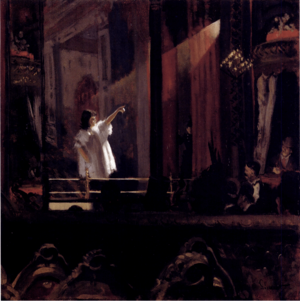
Other large music halls in the suburbs included:
- The Bedford in Camden Town. It was a favorite place for the artist Walter Sickert. He painted many scenes inside music halls.
- Collins's in Islington Green (1863). It was opened by Sam Collins. It was known as 'The Chapel on the Green'.
- Deacons in Clerkenwell (1862).
A well-known music hall owner was Carlo Gatti. He built a music hall called Gatti's in 1857. He sold it in 1862, and the site became Charing Cross railway station. With the money, Gatti opened a second music hall, "Gatti's-in-the-Road." In 1867, he opened another, "Gatti's-in-The-Arches." This one later became the Players' Theatre.
By 1865, London had 32 music halls that could hold between 500 and 5,000 people. There were also many smaller places. The number of music halls reached its highest point in 1878, with 78 large ones and 300 smaller ones. After that, the numbers went down. This was due to stricter rules and competition between the big halls and smaller ones.
A few of the UK's music halls still exist today. They have kept many of their original features. Some of the best examples are:
- Victoria Hall, Settle in Settle, North Yorkshire. It opened in 1853 and is the UK's oldest surviving music hall.
- Wilton's Music Hall in Shadwell. It was built in 1859 and is now a multi-arts performance space.
- The Britannia Music Hall in Glasgow, Scotland. It was built in 1857/58.
Variety Theater Takes Over
A new type of show, called variety theater, started when the London Pavilion was rebuilt in 1885. These new places were much grander. They used the best architects and decorators. The old, simple music halls became splendid "theatres of varieties." They had marble exteriors, fancy auditoriums, and bright electric lights.
One of the most famous new theaters was the Empire, Leicester Square. It was built in 1884 and got a music hall license in 1887. Another amazing example was the Tivoli (1888–90). In 1892, the Royal English Opera House became a music hall called the Palace Theatre of Varieties.
Two of the grandest new halls were the Coliseum Theatre (1904) and the London Palladium (1910). Both were designed by Frank Matcham. As music hall became more popular and respected, rules changed. Drinking was no longer allowed in the main audience area. Music hall was seen as a real cultural art form. This was shown by the first Royal Variety Performance for King George V in 1912. However, the most famous music hall entertainer, Marie Lloyd, was not invited. She was thought to be too "saucy" for the King.
The Music Hall Strike of 1907
In 1907, there was an important disagreement called the Music Hall War. It was a fight between performers and stage workers on one side, and theater managers on the other. On January 22, 1907, a dispute at the Holborn Empire grew worse. Strikes spread to other London halls. The Variety Artistes' Federation organized these strikes.
The strike lasted for almost two weeks. It became very well known. Important union leaders like Ben Tillett and Keir Hardie supported it. Performers formed picket lines outside the theaters. In other parts of the country, managers tried to make performers sign papers promising not to join a union.
The strike ended with an agreement that met most of the workers' demands. These included a minimum wage and a limit on working hours for musicians.
Many music hall stars supported the strike. These included Marie Dainton, Marie Lloyd, and Arthur Roberts. Even though they earned a lot of money, they fought for others. Marie Lloyd explained:
We (the stars) can dictate our own terms. We are fighting not for ourselves, but for the poorer members of the profession, earning thirty shillings to £3 a week. For this they have to do double turns, and now matinées have been added as well. These poor things have been compelled to submit to unfair terms of employment, and I mean to back up the federation in whatever steps are taken.
—Marie Lloyd, on the Music Hall War
Music Hall During World War I
World War I was a very popular time for music halls. Performers and songwriters helped to get public support for the war. Patriotic music hall songs were sung by audiences and even by soldiers. Some famous songs included "Keep the Home Fires Burning" (1914) and "Pack up Your Troubles" (1915). "It's a Long Way to Tipperary" (1914) and "We Don't Want to Lose You (But We Think You Ought To Go)" (1914) were also very popular.
Many songs encouraged young men to join the army. Others made fun of parts of the war. Vesta Tilley's song "I've got a bit of a blighty one" (1916) showed a soldier happy to have a small wound so he could go home.
Tilley became even more famous during this time. She helped with military recruitment. She performed songs as characters like 'Tommy in the Trench'. Young men were sometimes asked to join the army on stage during her shows. She also performed in hospitals and sold war bonds. She was called Britain's best recruiting sergeant.
Once the war became more serious, recruitment songs almost disappeared. After conscription (forced military service) started in 1916, songs mostly talked about wanting to go home. They also showed worry about the new roles women were taking in society.
One of the most famous music hall songs from World War I was "Oh! It's a lovely war" (1917). It was made popular by male impersonator Ella Shields.
The Decline of Music Hall
Music hall continued between the two World Wars. But it was no longer the most popular entertainment in Britain. The rise of cinema, radio, and cheaper record players greatly hurt its popularity. It now had to compete with jazz, swing, and big band dance music.
In 1914, new rules meant that drinking was banned from the main audience area. In 1923, separate bars were also removed by law. Some people said this law was unfair to working-class people. Even so, music hall still produced big stars like George Formby, Gracie Fields, and Max Miller during this time.
In the mid-1950s, rock and roll became popular. It attracted young audiences who were not interested in music hall acts. This drove away older audiences. Television also became very popular, especially after the Queen's coronation was shown on TV.
In 1957, writer John Osborne said:
The music hall is dying, and with it, a significant part of England. Some of the heart of England has gone; something that once belonged to everyone, for this was truly a folk art.
—John Osborne, The Entertainer (1957)
Moss Empires, the biggest British music hall company, closed most of its theaters in 1960. Many music hall performers lost their jobs and became poor.
However, stage and film musicals continued to be influenced by music hall. Examples include Oliver! and My Fair Lady. The BBC TV show The Good Old Days brought music hall back to modern audiences. It ran for thirty years. The Paul Daniels Magic Show also featured special acts from 1979 to 1994. The TV show The Muppet Show (late 1970s) also owed a lot to music hall.
Music Halls in Paris

Music hall first came to France in 1862. At first, French law limited what performers could do. But when the law changed in 1867, Paris music halls grew quickly. Many new halls opened, offering acrobats, singers, dancers, magicians, and trained animals. The first Paris music hall built for that purpose was the Folies-Bergere (1869). Others followed, like the Moulin Rouge (1889) and the Olympia (1893). Older theaters also became music halls. At first, music halls had dance shows and plays. But gradually, songs and singers became the main attraction.
Paris music halls faced strong competition from movies between the World Wars. They responded by offering bigger and fancier shows. In 1911, the Olympia introduced a giant stairway as part of its stage sets. This idea was copied by other music halls. The singer Mistinguett became very popular. She performed at the Folies Bergère and Moulin Rouge. She was one of the highest-paid French entertainers of her time.
One of the most popular performers in Paris was American singer Josephine Baker. She came to Paris in 1925 to perform in a show. She became an instant success. After touring Europe, she starred at the Folies Bergère. Baker performed a wild dance wearing a skirt made of artificial bananas.
Music halls faced more difficulties in the 1930s. The Olympia became a movie theater, and others closed. However, some continued to do well. In the 1930s, the Casino de Paris featured shows with Maurice Chevalier.
In 1935, a 20-year-old singer named Édith Piaf was discovered. A nightclub owner named Louis Leplée found her. He convinced her to sing even though she was very nervous. Leplée taught her how to perform on stage. He told her to wear a black dress, which became her signature look. Her nightclub shows led to her first records and the start of her career.
Competition from movies and television largely ended the Paris music hall era. However, a few still exist today, mainly for tourists. Famous ones include the Folies-Bergere, Crazy Horse Saloon, and Moulin Rouge.
Music Hall Songs
Music hall songs developed from traditional folk songs and songs from plays. By the 1850s, they became a unique style. The songs were often about modern and funny topics. Larger orchestras played the music. As people had more money, they could go to more shows. They also had more access to musical instruments like the piano. This led to a change in musical taste. People wanted new and easy-to-understand entertainment. This was because of the fast growth of cities and factories. New city communities needed new ways to be entertained.
Music halls were first pub rooms that offered music and special acts. By the mid-1800s, the first theaters built just for music hall were opening. These halls needed many new and catchy popular songs. Professional songwriters were hired to write them.
Music hall songs often had a series of verses sung by the performer alone. Then, there was a repeated chorus that the audience was encouraged to sing along with.
Music hall songs were often written for working-class audiences. Songs like "My Old Man (Said Follow the Van)" and "Waiting at the Church" talked about situations that city people knew well. Music hall songs could be romantic, patriotic, funny, or sad. The most popular ones became the basis for pub songs.
While some songs showed a clever and realistic view of working-class life, others were simple and written quickly just to earn money.
Famous Music Hall Songs
- "A Little of What You Fancy Does You Good" sung by Marie Lloyd
- "Any Old Iron" sung by Harry Champion
- "Ask a P'liceman" sung by James Fawn
- "Boiled Beef and Carrots" sung by Harry Champion
- "The Boy I Love is Up in the Gallery" sung by Nelly Power and Marie Lloyd
- "Burlington Bertie from Bow" sung by Ella Shields
- "Daddy Wouldn't Buy Me a Bow Wow" sung by Vesta Victoria
- "Daisy Bell (Bicycle Built for Two)" sung by Katie Lawrence
- "Don't Dilly Dally on the Way" sung by Marie Lloyd
- "Down at the Old Bull and Bush" sung by Florrie Forde
- "Good-bye-ee!" sung by Florrie Forde
- "Has Anybody Here Seen Kelly?" sung by Florrie Forde
- "Hello, Hello, Who's Your Lady Friend?" sung by Harry Fragson
- "I Belong to Glasgow" by Will Fyffe
- "I Do Like to Be Beside the Seaside" sung by Mark Sheridan
- "I'm Henery the Eighth, I Am" sung by Harry Champion
- "It's a Long Way to Tipperary" sung by John McCormack
- "Let's All Go Down the Strand" sung by Charles R. Whittle
- "Lily of Laguna" sung by Eugene Stratton
- "The Man on the Flying Trapeze" sung by George Leybourne
- "The Man Who Broke the Bank at Monte Carlo" sung by Charles Coborn
- "My Old Dutch" sung by Albert Chevalier
- "Nellie Dean" sung by Gertie Gitana
- "Oh! Mr Porter" sung by Marie Lloyd
- "Pack Up Your Troubles in Your Old Kit-Bag" sung by Florrie Forde
- "Ship Ahoy! (All the Nice Girls Love a Sailor)" performed by Hetty King
- "Ta-ra-ra Boom-de-ay" sung by Lottie Collins
- "Waiting at the Church" sung by Vesta Victoria
- "Where Did You Get That Hat?" sung by J. C. Heffron
Music Hall Comedy
Music hall comedians were often men or women dressed in special costumes. These costumes matched the song's topic or were just silly. Until the 1900s, the acts were mostly singing songs that told a story. There was not much talking between songs. Types of comedy included:
- Lion comiques: These were men dressed as rich gentlemen. They sang about drinking champagne, going to races, and living a fancy life.
- Male and female impersonators: These were performers who dressed as the opposite gender. Some, like Vesta Tilley and Ella Shields, used their acts to comment on society.
Special Acts
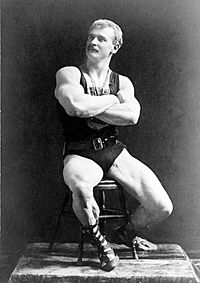
Besides singing, music hall shows also had many other kinds of acts. These were called speciality acts or "spesh." Over time, they included:
- Adagio: A mix of dance and juggling. Usually, a male dancer would throw a young girl around.
- Aerial acts: Like circus acts, with performers flying through the air.
- Animal acts: Talking dogs, flea circuses, and animals doing tricks.
- Cycling acts: Performers doing tricks on bicycles.
- Drag artists: Female entertainers dressed as men (like Vesta Tilley) or male entertainers dressed as women.
- Electric acts: Using new discoveries about electricity to do tricks.
- Escapologists: Like Harry Houdini, who escaped from difficult situations.
- Fire eaters: People who ate fire or other strange things like glass.
- Juggling and plate spinning: Acts where performers kept objects in the air.
- Knife throwing and sword swallowing: Dangerous acts with sharp objects.
- Magic acts: Performers doing illusions.
- Memory acts: People who could remember huge amounts of information.
- Mentalism acts: Performers who seemed to read minds.
- Mime artists and impressionists: People who acted without words or copied others.
- Comic pianists: Musicians who played the piano in a funny way.
- Puppet acts: Shows with puppets, sometimes even human puppets.
- Shadow puppet acts: Creating stories with shadows.
- Stilt walkers: People walking on tall stilts.
- Strongmen and strongwomen: Performers who showed off their amazing strength.
- Trampoline acts: Acrobatic acts using trampolines.
- Ventriloquists: Performers who made it seem like a dummy was talking.
- Wild West/Cowboy acts: Shows based on the American Old West.
- Wrestling and jujitsu: Shows of fighting skills.
Famous Music Hall Performers
- Fred Albert
- Harry Champion
- Charlie Chaplin
- Albert Chevalier
- Charles Coborn
- Gus Elen
- Joe Elvin
- Florrie Forde
- George Formby, Sr.
- Will Fyffe
- Will Hay
- Hetty King
- Harry Lauder
- Stan Laurel
- Dan Leno
- George Leybourne
- Marie Lloyd
- Little Tich
- Max Miller
- Nelly Power
- Arthur Roberts
- George Robey
- Ella Shields
- Mark Sheridan
- Vesta Tilley
- Vesta Victoria
Music Hall's Influence on Culture
Music hall has been shown in many films, plays, TV shows, and books.
- The 1935 film The 39 Steps uses a music hall act as a key part of its story.
- The 1944 film Champagne Charlie celebrated the Victorian era of music hall.
- Charlie Chaplin's 1952 film Limelight shows the music hall world of his youth.
- The Good Old Days (1953 to 1983) was a popular BBC TV show. It recreated the feeling of Victorian music hall with songs and acts. The audience dressed in old costumes and sang along.
- John Osborne's play The Entertainer (1957) is about a failing music hall performer. It shows the end of the music hall tradition.
- J. B. Priestley's 1965 novel Lost Empires also shows the world of music hall just before World War I.
- The band Herman's Hermits used music hall in their songs. They had a big hit with "I'm Henery the Eighth, I Am" in 1965.
- The Beatles were influenced by music hall, especially Paul McCartney. Songs like "When I'm Sixty-Four" (1967) show this influence.
- The film Oh! What a Lovely War (1969) featured music hall songs that supported the British war effort in World War I.
- The TV series Upstairs, Downstairs (1971–1975) often showed the world of Edwardian music hall.
- The band Queen used music hall styles in songs like "Killer Queen" (1974).
- Sarah Waters's book Tipping the Velvet (1998) is set in the world of music halls in the late Victorian era.
Music Halls Still Standing Today
London was the main place for music halls, with hundreds of them. As music hall became less popular, many were closed or turned into cinemas. However, some purpose-built music halls still exist. The Hackney Empire is a great example from the late music hall period (1901). It has been restored and now hosts many different shows. Hoxton Hall (1863) is another example that keeps its original look. Collins Music Hall (around 1860) still stands in Islington Green. It is now part of a bookshop.
In Clapham, The Grand (1900) has been restored. It is now a music venue and nightclub. The Greenwich Theatre was originally a music hall (1855).
In Grace's Alley, Stepney, stands Wilton's Music Hall. This 1858 hall survived being used as a church, fire, and war. It was almost falling apart in the 1960s. A group is working to restore it. In 2007, it was added to a list of the world's "100 most endangered sites." It was successfully restored and removed from the risk list in 2016. The music video for the song "Relax" by Frankie Goes to Hollywood was filmed here.
There are also music halls outside London that still exist. A good example is the Leeds City Varieties (1865). It was used for the BBC TV show The Good Old Days. The Alhambra Theatre, Bradford (1914) is another fine example of the late Edwardian style.
In Nottingham, the Malt Cross music hall has its restored cast-iron interior. It is now a cafe bar and still hosts new musical acts.
In Northern Ireland, the Grand Opera House, Belfast (1895) was restored in the 1980s. The Gaiety Theatre, Isle of Man (1900) is another restored theater still in use. In Glasgow, the Britannia Music Hall (1857) still stands, but it needs a lot of repair.
One of the few places that still offers full music hall entertainment is the Brick Lane Music Hall in North Woolwich. The Players' Theatre Club also performs Victorian-style music hall shows.
Images for kids
-
Interior of the Canterbury Hall, opened 1852 in Lambeth
-
Little Dot Hetherington at the Old Bedford by Walter Sickert; c. 1888
-
The Café-Concert by Edgar Degas (1876–77)
-
Josephine Baker dances the Charleston at the Folies Bergère (1926)
-
Strongman Eugen Sandow
-
1867 Poster from the National Standard Theatre, Shoreditch (1837–1940). Not strictly a Music Hall, but a theatre where many of these artists performed their Music Hall acts.
See also
 In Spanish: Music hall para niños
In Spanish: Music hall para niños
- Cincinnati Symphony Orchestra
- Concert saloon
- Friedrichstadt-Palast
- History of music in Paris
- Radio City Music Hall
- Tivoli circuit


